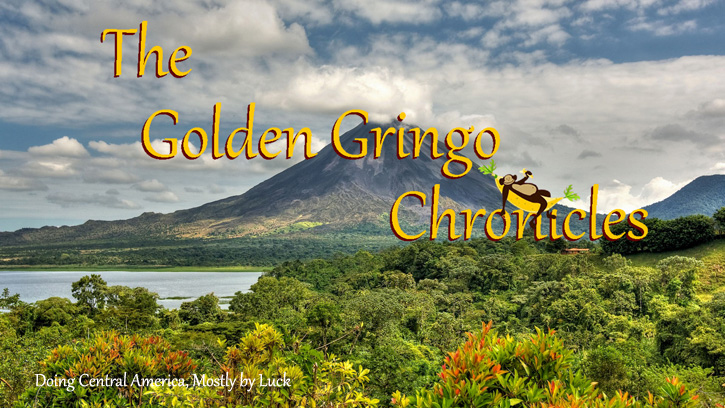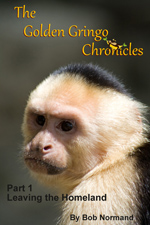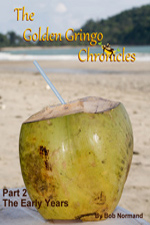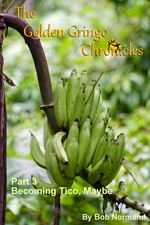|
|
|---|---|
Edition 69 - May 2014 Published at Quepos, Canton of Aguirre, Province of Puntarenas, Costa Rica (© Copyright 2014 - All Rights Reserved) |
NEW! The Golden Gringo Chronicles are now available as a trilogy of novels, in E-book format compatible with all electronic platforms. Part 1: Leaving the Homeland (Available Now) |
(Nota Bene: The weather link from freemeteo.com for Quepos has been eliminated beginning with this issue because it claimed consistently and embarrassingly that it was raining every day in Quepos for the last month when in fact it was bone dry. Maybe a solar flare affected the weatherometer but, in any case, it was dead wrong; adios amigos de tiempo)
Broken News
(All the News That's Fit to Reprint)
 |
President Elect Luis Guillermo Solis |
The March Edition of the Chronicles reported on the successful campaign by the supposedly second favorite candidate in this year's presidential election, Luis Guillermo Solis. Solis came out ahead by about 1% over the favored candidate, San José mayor Johnny Araya in a surprising upset.
Since neither candidate received 40% of the vote, the Costa Rican constitution required a run-off election which was held on April 6. In the meantime Araya cancelled his campaign, virtually assuring a Solis victory, although the Araya name stayed on the run-off ballot. As expected, Solis garnered 78% of the run-off vote in a landslide and will take over the reins of government from current president Laura Chinchilla, the first woman president of Costa Rica, on May 8. Costa Rican law prevents one person from holding presidential office for two consecutive terms, so Laura could not run again this time.
Within one week of winning his election, Solis had made 22 appointments to his cabinet out of a total of 32 slots. Nine of them were women, coming close to his goal of maintaining roughly 50% female in his appointments. Their were no surprises and little controversy among his appointees, several receiving plaudits from their respective professional communities. Pretty good start, Luis.
Provincial elections, including National Assembly deputies, mayors, vice-mayors and others occur on the off year cycle here so the next set of non-presidential elections will happen in 2016. The question will be if Solis' party, the Partido Acción Ciudadana (PAC) or Citizens Action Party will be able to win a majority of the National Assembly for the first time in its history. That, combined with Solis' presidency might mean a major change in direction for the country.
Either way, President Solis will have his hands full; just read the next two reports in this section.
Basic Ecology
In a country with exceptional bio diversity that prides itself, and rightly so, on its tremendous natural assets and desire for ecological protection, most people are surprised to learn that currently only 4% of sewage in Costa Rica is treated. The reason is obvious; sewage treatment is expensive and often beyond the capability of a developing country, even in the highly populated areas where collection is more efficient.
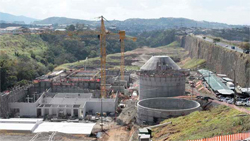 |
New Sewage Plant Los Tajos Section of La Uruca |
Costa Rica is trying to catch up, but the need is daunting. A new sewage treatment plant is under construction in La Uruca, a western suburb of San José. When completed it is expected to treat some 65% of the central valley sewage that currently goes untreated into the Tarcoles River and then into the Pacific Ocean.
Since the central valley represents about 60% of the population of Costa Rica, that means the country-wide treated percentage, after the project is complete, will go up to 40-45%. There will still be more than half the nation's effluent untreated and that amount will be in areas much less able to be concentrated and collected efficiently (like Quepos/Manuel Antonio).
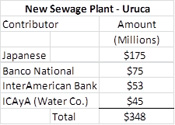 |
Source of Funds La Uruca Project |
At the conception and proposal of the La Uruca project back in 2005, the cost was estimated at $250 million but since then the estimate has risen to $348 million. The plant being constructed comes in at around $45 million or only 13% of the total; the remainder of the funds is required for new sewers to collect and direct the sewage to the plant.
So far, about two-thirds of the money pledged has come from the Japanese Bank for International Development and The InterAmerican Bank. The balance is pledged from several sources including the Costa Rican Banco Nacional and the Water & Sewer Company (AA y A), both of which are quasi-public companies controlled by the government. Note that no money is coming directly from the federal government budget. A $348 million dollar project here is the equivalent of a $92 billion project in the U.S., on a total budget to total budget comparison.
GGC will watch this story as it develops.
Intel Corp. announced in early April that it would be moving its Costa Rican manufacturing operations to Asia, particularly Vietnam and maybe Malaysia and China. In Ho Chi Mi nh City (Saigon) alone, the company has a 500,000 square foot manufacturing plant.. A total of some 1,500 relatively high-tech jobs or nearly 60% of Intel's Costa Rican work force would be eliminated here. Some 1,200 employees would be retained in finance, information technology, engineering and research, at least for now.
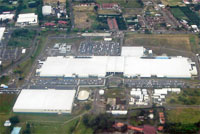 |
Intel Complex in Hereditary |
Intel was the shining star in foreign investment in Costa Rica having first opened facilities here some 15 years ago. Its presence in Costa Rica is believed to have influenced dozens, if not hundreds of other companies, many high-tech, in their decision to locate here. In 2013. the company accounted for nearly 21% of all Costa Rican exports. Because of the slow down in the PC industry, Intel is cutting 5,400 employees worldwide. Unfortunately, the loss of jobs in Costa Rica will account for almost 30% of that total.
Some press reports indicated that the expected future profit picture combined with bureaucratic difficulties was making Costa Rica less attractive to Intel. An initiative to move to a 4x10 hour work week which the company maintains is more efficient (and GG believes is more attractive to the worker) was quashed by the government. Then the Chinchilla administration proposed a new 30% export tax recently which barely failed passage in the assembly. The company has also expressed concern in the past about the country's ballooning annual deficit and its potential effect on long term financial stability of the nation.
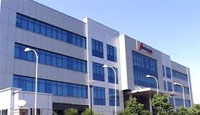 |
BA Continuum - San José |
Only a couple of days after the Intel bombshell, Bank of America announced that it was terminating operations of its subsidiary in Costa Rica, BA Continuum. Some 1,400 call center/information agents will be terminated. No immediate reason was given by Bank of America for the closing.
Well, Mr. Solis, here's another potential trend you'll need to work on and hopefully reverse. A couple of days later a press report stated that the outgoing Minister of Commerce said not to worry , Costa Rica still has many foreign investors. That's easy to say - her successor will have to deal with the problem. Other press reports said the unworried lady is off to work for the World Bank.
On a population to population ratio, the loss of jobs represented by the Intel and BOA pullouts here would be equivalent to a job loss in the U.S. of about 220,000 people. Any way you cut it, it's not good news.
At press time the Intel and BOA pullouts seemed like done deals.
¡Pura Vida!
Exit the Exit Tax
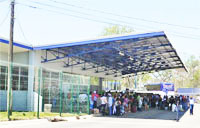 |
Costa Rica - Nicaragua Border Crossing at Peñas Blancas (The Line is Half Again as Long Inside) |
The Chronicles reported a few months ago that Costa Rica was trying to impose a new border tax at land crossing points. This would be $5 plus a $2 baggage check charge (even if you didn't have a bag) for a total of $7. The first try came earlier this year but failed because the border people and the tax authority (Ministerio de Hacienda) were not coordinated. When people showed up to pay the tax their was no way to pay it (that's GG's kind of tax).
In early March when GG and a couple of his buds took a Trip to Nicaragua, the new tax was under suspension and was never mentioned (yeh!). But the tax hungry bureaucrats took aim at April 1 as a new start date and installed ATM-like machines at the crossing points to collect the tax.
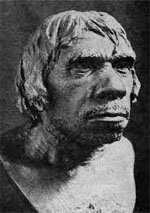 |
Been Waiting a Long Time at the Border? |
Now comes word that the tax has been suspended again. The hang up at the Nicaraguan border at Semana Santa was monumental, adding another hour and a half to a process that already required at least an hour (dude, those ATM machines must have been really slow, amigos). Of course, there were still many people that didn't have ATM cards. Many of the travelers were Nicaraguans going home for the holidays. Remember, it is estimated that as much as 15% of the population in Costa Rica is Nicaraguan, legal or illegal.
Some 3,925 persons left Costa Rica at the Peñas Blancas/Nicaragua border crossing alone just on Friday, a week before Easter weekend. The reason for the delay, of course, is that most revelers have no idea that the tax exists. Those who arrive at the border without paying the $7 tax at a local bank can only pay the tax at a machine that only accepts credit cards. Good planning from the Ministerio de Hacienda, eh.
So for the time being there will be no land exit tax but fear not, there's no doubt that the taxocrats will be back soon with a new and improved model to get their money, er, your money.
Remember, we're just talking about the land exit tax here, not the $28 tax one pays to leave the country by air; that one is still comfortably in place and easily paid at the airport on departure.
¡Pura Vida!
Rumble Talk
(Shaky Happenings On or About the Pacific Rim)
After Shocks
We tend to think of a terremoto (earthquake) as a single event but often there is a series of shocks that hit, sometimes before the major shaker, but often afterwards - that's why we call them after-shocks. Take the recent terremoto in Chile on April Fool's Day, which was 8.2. Yikes, what a number; that's 50% stronger on the logarithmic Richter scale than the 7.6 that hit here in Costa Rica on September 5, 2012, which was then the second strongest earthquake ever to hit Costa Rica. The fact that the death and injury tolls were relatively light in Chile this time gives testimony to good earthquake planning and improved building codes in that country.
But terremotos often come in groups. Check out the data below from the U.S. Geodetic Survey. After the big one in Chile hit about noon on April 1, there were 13 major aftershocks in the next two hours ranging from 4.7 to 6.2 on the Richter. Damage at these Richter levels is usually minimal but after going through the big one, they still can be unsettling (couldn't resist the pun), to say the least. Also, it is not unknown that sometimes the aftershock becomes the main event. The great Costa Rican earthquake of September 5, 2012 generated over 300 measurable aftershocks in the 24 hour period following the big one.
1 Apr 2014, Irquique, Chile
- 8.2, 95km NW of Iquique, Chile 2014-04-01 17:46:46 UTC-06:0020.1 km
- 4.9, 76km W of Iquique, Chile 2014-04-01 19:35:47 UTC-06:0010.0 km
- 4.8, 97km SSW of Arica, Chile 2014-04-01 19:33:56 UTC-06:0010.0 km
- 5.2, 75km WNW of Iquique, Chile 2014-04-01 19:29:41 UTC-06:0010.0 km
- 4.7, 64km WNW of Iquique, Chile 2014-04-01 19:22:55 UTC-06:0010.0 km
- 5.3, 111km NW of Iquique, Chile 2014-04-01 19:20:58 UTC-06:0010.0 km
- 4.7, 59km NW of Iquique, Chile 2014-04-01 18:57:50 UTC-06:0032.8 km
- 5.4, 46km WNW of Iquique, Chile 2014-04-01 18:37:49 UTC-06:0021.5 km
- 5.5, 56km W of Iquique, Chile 2014-04-01 18:33:45 UTC-06:0012.6 km
- 5.6, 70km WNW of Iquique, Chile 2014-04-01 18:24:45 UTC-06:0010.0 km
- 5.7, 95km NW of Iquique, Chile 2014-04-01 18:06:44 UTC-06:0010.0 km
- 5.8, 87km WNW of Iquique, Chile 2014-04-01 18:03:12 UTC-06:0010.0 km
- 6.2, 88km N of Iquique, Chile 2014-04-01 17:58:00 UTC-06:0018.1 km
- 5.7, 92km NW of Iquique, Chile 2014-04-01 17:56:47 UTC-06:0010.0 km1.
The Chile quake caused a Tsunami warning to be issued all the way up the coast to Costa Rica and beyond. We're happy to report that the big wave didn't materialize.
Feeling the 6.6 Tremblor in Nicaragua
Bulletin: Thursday, April 10, when GG was busy working on the following article, the room began to quiver and the walls to creak; a 6.6 R shaker hit the small town of Nandaime on the Interamericana Highway, half way between the towns of Rivas and Granada in Nicaragua, causing considerable damage in the Managua area and several lost lives. Nandaime has to be at least 100 miles from Quepos as the cockatoo flies but we easily felt the tremor. The roving ROMEOS must have passed through this town in March on their sojourn into Nicaragua. No tsunami from this one though, the crack in the plates was under land.
| Check Out Recent Earthquakes Around the World Posted by the U.S. Geodetic Survey: Today's Quakes |
|---|
¡Pura Vida!
Tsu, Tsu, Tsu Tsunami
(Waiting for the Big Curl)
The Chronicles had an article last month on The Power of Moving Water extolling some of the benefits of taking advantage of the potential and dynamic energy in large bodies of flowing water to generate power. There are, of course, negative and dangerous effects also and here is one of them.
Shortly after the huge earthquake hit the coast of Chile on April Fool's Day this year, a Tsunami warning was issued for much of the South American west coast and then extended all the way north to include most of Central America as well. Fortunately, a devastating Tsunami did not appear anywhere along this area.
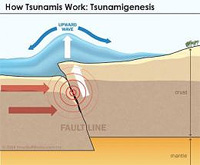 |
Tectonic Plate Displacement Can Cause Tsunamis |
Tsunamis are a potential threat every time a sizeable earthquake occurs in the ocean. A Tsunami is a series of waves generated by a large and sudden disturbance in the water. They can be caused by an earthquake, landslide, volcanic eruption, or meteorite impact. The genesis of an earthquake-generated Tsunami is shown in the diagram to the right. Generally speaking, an earthquake needs to be a Richter 7 or above to generate a significant Tsunami.
The sudden displacement of the tectonic plates, one slipping under the other, causes a fast upward rush of what can be gigantic amounts of water, sometimes over hundreds of miles laterally and the resulting generation of a great wave. Like earthquakes, the size and severity of a Tsunami depends on how far below the surface the rift occurs. Multiple slips in the plates can generate more than one set of multiple waves but each act of displacing the water can also cause ripples or multiple waves..
The generation of Tsunamis can be likened to dropping a large rock into a still pond. A series of concentric waves is created that travel outward in all directions. Dropping a large enough rock (like the 90-mile wide meteorite that is credited with helping to extinguish the dinosaurs) or sudden displacement of hugh amounts of rock at the ocean bottom from a tectonic plate shift can cause multiple waves.
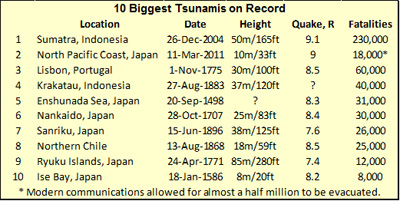 |
If a wave is generated in the deep ocean, it may only be about 1-3 meters (3-10 feet) in height on the surface; not even noticeable to a ship passing through it. The wave travels very fast, in some cases in excess of 1,000 km/hour (600 miles per hour). As it approaches shore and the depth becomes shallower, the waves slow and become higher.
The distance between wave crests (wavelength) can be hundreds of miles. The time distance between waves is called its period, and even traveling at 600 miles per hour, it may take a few hours in a sea the size of the Indian Ocean for the waves to reach shore in some places; Africa was more than 3,000 miles from the Sumatra earthquake but the wave still killed people in several countries there.
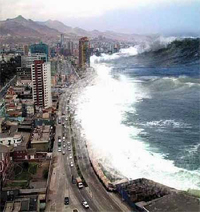 |
2004 Wave at Sumatra |
The top ten Tsunamis on record are shown on the table above, ranked by a combination of earthquake strength and fatalities. Note that Asia has been the scene of most of the really bad ones and Japan has the lion's share of those (6). While it is somewhat comforting to see that most of the major Tsunamis occurred in previous centuries, the recent experiences in Indonesia and Japan show they can still be major events, and incomparable killers.
The greatest Tsunami wave on record was about 50 meters (165 feet!) high and hit Sumatra, Indonesia in December of 2004. The picture to the right shows the wave and no, that is not a Photoshop synthesized wave but an actual picture. The 2004 Tsunami killed as many as 250,000 people in the South Asian basin including Sumatra and other parts of Indonesia, Malaysia, Sri Lanka, Thailand and several countries in Eastern Africa, a total of 11 countries in all.
Secondary Wave from 2004 Sumatra Earthquake Hits Thailand |
The 2004 Tsunami East of Sumatra occurred over a fault line nearly 1,300 km long (about 800 miles) and the ocean floor was displaced by several meters (10-20 feet). The 50 meter high wave that resulted at the shoreline, traveled inland as much as 5 kilometers or 3 miles into that country.
In the more recent Japanese earthquake (2011) and disastrous Tsunami, good warning communications reduced the fatalities dramatically; otherwise the fatalities would have very likely been the highest in history. Most of the 450,000 people involved relocated in time but nevertheless lost their homes.
International cooperation has relulted in the placement of many sensors around the globe designed to pickup sudden changes in sea height. This is why today we here of many more "potential" Tsunamis than we used to. Following the promulgation of the waves allows scientists and meteorologists to predict when a specific wave will hit land. Depending on how far a shore area is from the epicenter that warning may be from minutes to several hours.
Quepos has had a Tsunami alarm for some years now. GG only heard it once, I suspect when it was first installed and was being tested. GG has his eye on a high hill behind the barrio where he lives in Quepos - you'll find me there (hopefully) if our Tsunami alarm at the firehouse goes off.
¡Solo Bueno!
Surviving Semana Santa
(Holy Moley, Where Did Y'all Come From?!)
Sunday, April 13 (Domingo de Ramos or Palm Sunday) through Sunday, April 20 (Pascua or Easter) was Semana Santa or Holy Week this year in Costa Rica. The Chronicles first reported the significance of Semana Santa in Costa Rica to our readers in an article in May of 2011 entitled Semana Santa.
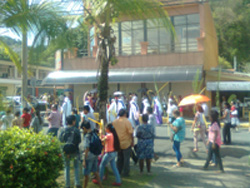 |
Palm Sunday March in Quepos |
Much of the week is traditionally devoted to religious practice starting on the friday before Palm Sunday, which this year happened to coincide with a national holiday devoted to the memory of Juan Santamaria, a historical figure and hero in Costa Rica. The coinciding of the national hero's holiday and Semana Santa in effect extended the holy week holiday to 10 days from seven.
On the religious side, the next event occurred on Domingo de Ramos or Palm Sunday. In many villages, towns and cities, including Quepos, a march is held with people dressing up in period garb and imitating Christ's entrance into Jerusalem. Palm fronds proliferate, as the raw material is not hard to get here. Our local bus up the Manuel Antonio hill on Palm Sunday morning had to make a small diversion to get around the march.
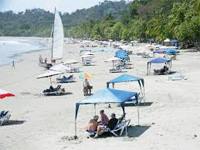 |
Manuel Antonio Beach |
In addition to it's religious significance, Semana Santa is one of the two most popular vacation periods for Ticos, the other being Christmas/New Year's week. The weather is optimum for the beach, there is very little, if any, rain; there is full sun, warm ocean waters (82-84ºF) and muchas vendors to keep you supplied with coconut water, drinks, empanadas, ceviche, snow cones and a myriad of other goodies while you relax on your beach chair under an umbrella. Life is good here during Semana Santa; life is good here every week.
But GG avoids going to the beach during this week. Why? Semana Santa and Christmas week are the two periods that draw great numbers of people from the Central Valley to shore points. These are the people we call (lovingly) "comehuevos" (egg eaters - take the link to find out why they're called this). The picture above right is of Manuel Antonio Beach but the scene depicted is more reminiscent of a Sunday during the high season than Semana Santa. For Holy Week, add 50% more people to the picture, many pup tents (tiendas de camapaña) and umpteen vehicles backed up to the edge of the beach blaring hispanic rap music and you've got Labor Day in Wildwood, N.J. but with a latin beat. And, of course, easter week is also a favorite get-away time for spring-breakers and other foreign tourists adding even more to the crowds.
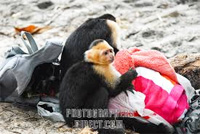 |
Another Kind of Thief on Manuel Antonio Beach |
Putting up with the tourists and visitors (someone once said: "If there is a tourist season, why can't we shoot them?") is one thing but, unfortunately, the large crowds also draw the "ladrones" (thieves) out from the cities and some of these miscreants are quite professional. Tourists, visitors and locals all need to watch their wallets and personal items closely during this period.
Never put a camera down unattended, never go into the water leaving personal items unsupervised. don't flash money, take only the minimum of money with you to the beach, leave your passport and credit cards in the hotel safe (take a copy of the first page of your passport in your wallet or bag). Use common sense to avoid an interruption of your vacation at the police station and the hassle of trying to get your money and cards replaced while in a foreign country.
This advice holds for public busses as well. All three of the founding ROMEOs were pick pocketed on busses during their first years here and it was during the Christmas or Semana Santa holidays. Making light of it, one of our guys suggested we change the acronym from "Retired Old Men Eating Out" to "Retired Old Men Enriching Others"! Losing the money is unfortunate (once GG had his pocket picked for over $200 as he was headed to San José) but replacing U.S. based debit/credit cards was much more of a hassle.
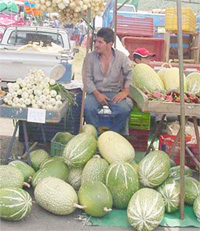 |
Chiverre Squash |
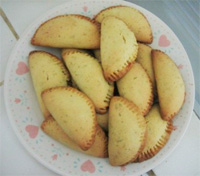 |
Empanadas de Chiverre |
Semana Santa, of course, ends at Pascua (Easter). Certain foods are found on Costa Rican tables at this time of year, like Chicharrones, those juicy little pieces of pork deep fried to a golden brown (yummers). Traditional enthusiasts start with a side of pig and a machete. Chicharrones are a particular favorite at New Year's but are only brought out on Easter day during this holiday because during the whole week of Semana Santa no meat is eaten.
Many kinds of canned fish are popular at this time, particularly tuna and sardines. The shelves of supermarkets are piled high with various brands and types of these two favorites. This is high season for fresh fish markets as well.
But the most interesting food that GG has found is the method for rendering a very large squash called Chiverre into a honey like paste that is incorporated into an empanada. Preparing Chiverre is not for the faint of heart; here are the directions:
Ingredients:
One large chiverre, two cakes of Tapas de Dulce or 1 kilo brown sugar, cinnamon, cloves, 250 grams brown tamarind seeds (Optional) and 250 grams of coconut pieces or flakes (Optional).
Preparation:
- Over a fire or using a kitchen burner, char as much as possible of the shell of the Chiverre.
- When done, hit the shell firmly with a hammer to expose the contents which looks like spaghetti squash or fine hairs. (These dudes are really tough!)
- Put the insides into a clean pillowcase and use the clothes drier to reduce the moisture.
- When the chiverre contents are drier, cook it in a big sturdy pot over low heat. Cover the entire flesh of the chiverre with whichever sugar you are using, white, brown or the tapa. Sprinkle with the tamarind seeds, cinnamon, cloves, lemon or orange peel and if desired, the coconut. The chiverre will naturally produce enough liquid to complete this process.
- Cover the pot and let it cook slowly over low heat for 90 minutes, stirring often to avoid sticking.
- Allow to cool and either transfer to a jar or use for other dishes.
Or, like GG, you can simply look about town until you find the empanadas de chiverre on sale.
¡Tuanis!
Quema de Judas
(Burn, Baby, Burn)
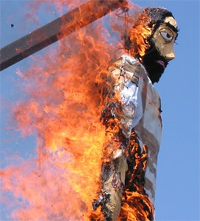 |
Quema de Judas |
There are many holiday traditions in Costa Rica and some of them were pointed out above. One of the more dramatic traditions at Easter time is the Burning of Judas or Quema de Judas. Traditionally done on Easter day evening (but in some parts of Latin America also on New Year's Eve), an effigy of Judas Iscariot, the dude that betrayed Jesus as the story goes, is hung and then ignited.
In some parts of Latin America "the burning" occurs on the eve of the new year as a symbol of ridding one's self of evil and beginning a new year in spiritual purity (the New Year's Eve parties GG attended over the years had an almost reverse purpose). When done at New Year's, and the effigy is burned on a stake, it is invariably called "Quema del Año Viejo" meaning literally "the burning of the old year."
In the case of New year's burnings, the effigy does not necessarily need to be Judas, but may be Satan, a harlot, or a Jew, the latter stereotyped as the European depiction of a Jewish male with a goat beard, side locks, and a black frock coat. Understandably, this has been a source of anti-semitism and much criticism and anger has been waged against the practice as a result. Hopefully, this representation is dying out.
 |
Cabezuela del Valle Festival Banner |
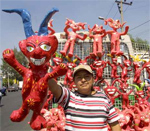 |
"Get Your Devil Dolls Here!" |
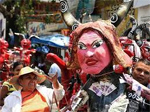 |
This One Resembles GG's Third Grade Teacher |
The burning of Judas was widespread in Europe, particularly in Spain, for centuries. It was practiced in the district of Dingle, in Liverpool, England into the early 20th century before it was subsequently banned. In modern times more and more countries are trying to ban or at east discourage the practice for safety reasons. In addition to the practice dying hard in Costa Rica, it is still practiced in parts of Greece, Mexico, Brazil, Portugal, Spain, Uruguay, Venezuela, Cyprus (where it is called 'lambratzia'), the Philippines and elsewhere.
Whole festivals related to the burning of the effigy cropped up over the centuries, one of the best known among them continues to be held at Cabezuela del Valle ("Head of the Valley"), a tiny village in Spain located in the mountains west of Madrid and east of central Portugal. The population is only about 2,200 but, as the banner to the right suggests, the festival is still an annual affair, probably the biggest thing that happens in that town all year.
Costa Rica is one of the countries trying to discourage Quema de Judas. This past Easter police reserves fanned out in the Central Valley and confiscated some 20 effigies in Alajuela, Ciudad Colón, Escazú and Heredia. Eight persons were detained on misdemeanor charges ("persons" are "detained" in Costa Rica, people are never arrested). I guess things are getting better because last year fifty-four persons were detained. The most prominent burning enthusiasts this year came from the Guararí, Birrisito, Santa Bárbara and Barva districts of Heredia.
GG suspects that the modern practice of burning people in effigy and in fact, burning anything as a sign of disrespect, came from this religious practice. In Venezuela last month hundreds of students ignored the pleasure of Quema de Judas in favor of burning an effigy of their president, Nicolás Maduro.
The sentiment in the Venezuelan crowd was that they wanted to send the prez to Cuba, where he would be more comfortable. It was all about the 50%+ inflation rate in Venezuela and the shortage of basic foodstuffs, like corn meal, cooking oil, sugar, butter and chicken. I guess they ran out of the money they gained when the government nationalized the petroleum industry a few years back and instituted price controls under Sr. Hugo Chávez a few years ago.
It's likely that Sr. Maduro will continue to feel the heat (pun intended).
¡Pura Vida!
What's-in-a-Word
Tsunami 津 (tsu) 波 (nami)
Tsunami (soo-NAH-mee) is a Japanese word represented by two characters: "tsu" and "nami" (above). The character "tsu" means harbor, while the character "nami" means wave. Harbor wave seems a little under-dramatic in describing these killer waves.
Tienda de Campaña
In Costa Rican Spanish anyway, this simply means "tent". Simply and literally translated it is "country store". In practice the campaña part is left off and only teinda is used.
ROMEO Corner
(Retired Old Men Eating Out)
La Colina, Manuel Antonio
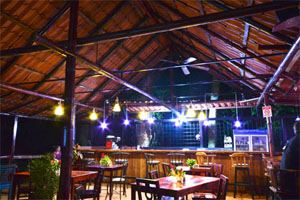 |
Restaurant at La Colina |
Location: Manuel Antonio hill about 200 yards (150 meters) down the hill from the football field on the Pacific side. La Colina Restaurant is a part of a hotel with the same name.
Hours: Monday thru Sunday, Breakfast, Lunch and Dinner
Parking: Parking on site available.
Contact: Tel.: (506) 2777-0231; Email: lacolina07@gmail.com; Website: http://www.lacolina.com/
Reviewing ROMEOS: Brian M., Davis H., Bob N.
To Review Our Rating System and Procedure, go here: R.O.M.E.O. Rating System
This restaurant is is not as obvious to the naked eye as many in Manuel Antonio as the hotel complex sits well in from the main Manuel Antonio road. The sign on the main road is minimal but lighted at night.
The feeling is that you're in the middle of the jungle. The restaurant does not have a Pacific view so getting there early (5 PM) doesn't add anything to the dining experience.
That's the good news; the bad news is that the entire complex is located on the side of a steep hill and the restaurant is about 50 steps up a steep incline with no elevator. The rest rooms are half way up the steps requiring descent and re-ascent if you use them during a meal. GG wondered how La Colina was surviving the recent push by local authorities to require handicap access, a requirement that has closed down a few restaurants recently and caused others to relocate.
The restaurant itself conforms to what might be called Manuel Antonio standards, i.e., lots of wood everywhere including wooden chairs and tables. GG has come to call this motif "Manuel Antonio Eat-in-the-Rough". For atmosphere we give La Colina an average of four sloths, a few points more for the jungle atmosphere, a few less for accessibility.
The restaurant bills itself as a steak house but, in fact, the menu offers quite a variety of steaks, other meats, seafood and pasta dishes. casados and ceviches. GG chose a pork tenderloin grilled on a lemon grass skewer and served with a honey-ginger sauce. Simply delicious. It was served with (another MA standard - ) the proverbial mashed potatoes and steamed vegetable medley. Another ROMEO had a beef filet that was tender and cooked "au point" as the French say ( I sampled it and it was very good). Another ROMEO opted for the Thai curry pasta with shrimp which he also thought was delicious. We all had desserts that were ample and tasty, mine being a key lime pie served with a scoop of ice cream and drizzled with chocolate sauce. |
 |
|---|---|
$$$$ |
|
Value Index = 100 |
We were served by a courteous and helpful lady who turned out to be one of the owners, Natasha, a lady of Russian origin. For overall atmosphere, quality of food and service we give La Colina four sloths.
My bill for the pork dish, two soft drinks and the dessert came to just over 15,000 colones or just about $30. (Actually, I revived the receipt later and noticed I ended up paying for some chips and salsa ordered by another ROMEO - that'll teach me not to look closely at the bill). With the chips and salsa, my bill came to about $35, full pricing even for Manuel Antonio. We give La Colina Four $ for cost. That's a value index of 4/4x100 = 100, right in the middle of our rating system for value.
La Colina presents an Manuel Antonio alternative for good food in an interesting setting but be prepared to pay full Manuel Antonio prices and bring your hiking boots to access the restaurant.
don Beto de Quepos,
El Gringo Dorado Pura Vida! |
Be pithy but kind. I'm sensitive. |
|---|
